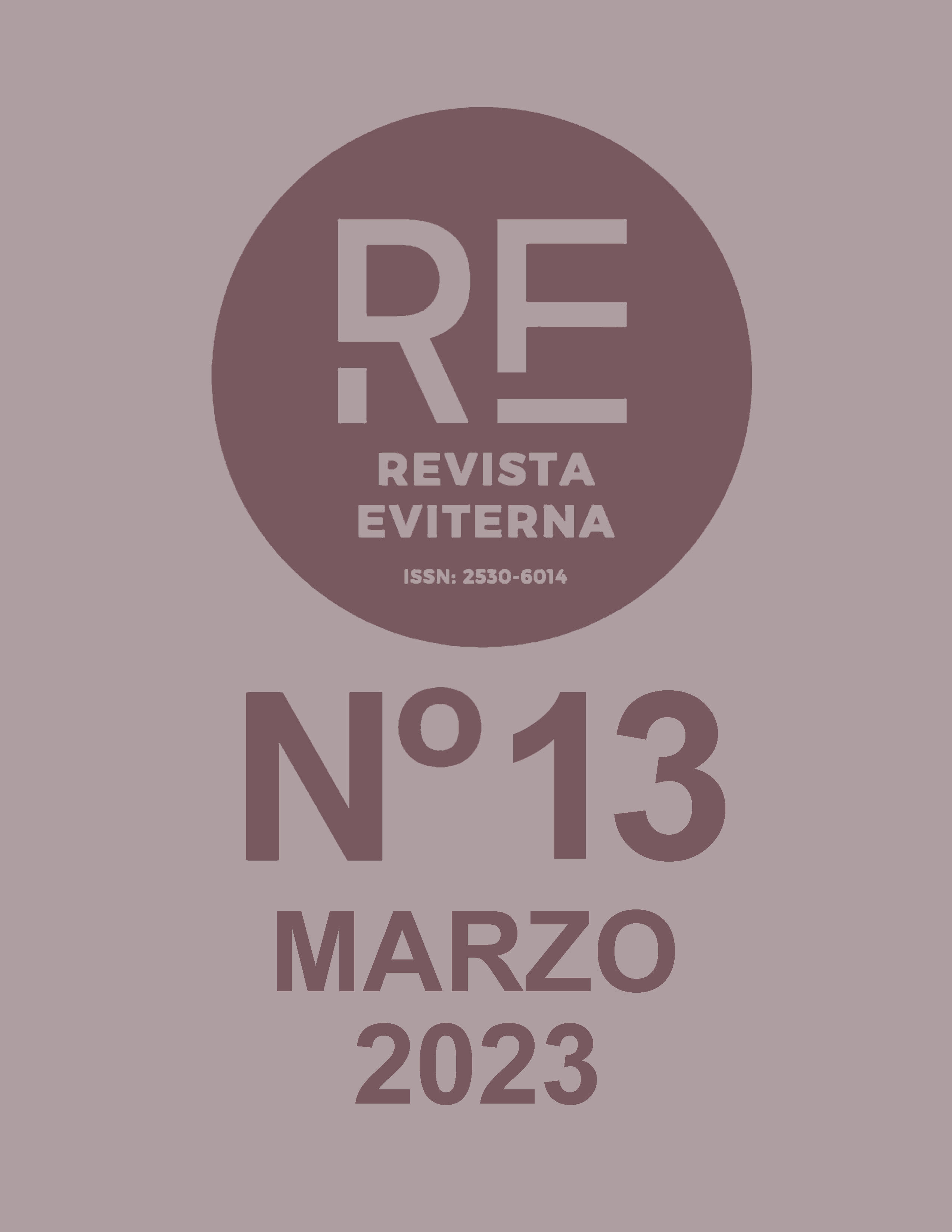El Trasfondo político-religioso contra el Iconoclasmo en Juan Damasceno
DOI:
https://doi.org/10.24310/Eviternare.vi13.15735Palabras clave:
calcedoniano, diotelismo, iconófilo, sabaítasResumen
Aunque la fama de Juan Damasceno (ca. 675-ca. 754) como teólogo y defensor de las imágenes sagradas es un hecho reconocido, su influencia en la controversia iconoclasta de los siglos VIII y IX es difícil de precisar. Las fuentes que pudieran aportar datos fiables sobre el autor y su obra son problemáticas, lo que dificulta la labor de contextualizar correctamente al monje de Damasco. En este artículo tenemos la intención de mostrar su oposición a la intromisión de la esfera del poder temporal en los asuntos eclesiásticos tal como se desprende de su apología de los iconos. Creemos que, si se analiza este episodio a la luz de la disputa de Máximo el Confesor un siglo antes contra la herejía monotelita, puede reflejar apropiadamente el trasfondo político-religioso y doctrinal de la contienda de las imágenes sagradas, que llevó al iconoclasmo institucionalizado a excomulgar a nuestro autor en cuestión y condenarlo a una damnatio memoriae.Descargas
Métricas
Publicación Facts
Perfil de revisores N/D
Información adicional autores
Indexado: {$indexList}
-
Indexado en
- Sociedad Académica/Grupo
- N/D
- Editora:
- Universidad de Málaga
Citas
Ables, S. (2018). Was the reestablishment of the Jerusalem Patriarchate a “Proto-Melkite” gambit orchestrated by John of Damascus –Quid Pro Quo: Cathedral for Patriarchate? ARAM 30 (1-2) 1-13.
Alexakis, A. (1996). Codex Parisinus Graecus 1115 and Its Archetype. Dumbarton Oaks Studies.
Auzépy, M.-F. (2007). L’histoire des iconoclastes. Bilans de recherche.
Brubaker, L.-Haldon, J. F. (2001). Byzantium in the Iconoclast Era (ca. 680-850). The sources: an annotated survey.Aldershot.
--- (2011). Byzantium in the Iconoclast Era (ca. 680-850): A History, Cambridge University Press.
Burgman, L. (1983). Ecloga. Das Gesetzbuch Leons III. und Konstantinos V. Frankfurt am Main.
Chabot, J. B. (1924). Chronique de Michel le Syrien, patriarche jacobite d’Antioche (1166-1199), vol. 2. Paris.
Dagron, G. (1993). Le christianisme byzantine du VIIe au milieu du XIe siècle, en Dagron, G.-Riché, P.-Vauchez, A. (dir.), Évêques, moines et empereurs (610-1054), Paris, 1-348.
Gallina, M. (2016). Incoronati da Dio. Per una storia del pensiero politico bizantino. Viella s.r.l.
Geerard, M. (1979). Clavis Patrum Graecorum, vol. 13. Turnhout.
Gero, S. (1977). Byzantine Iconoclasm during the reign of Constantine V with particular attention to the Oriental sources. Corpus Scriptorum Christianorum Orientalium.
Gouillard, J. (1968). Aux origines de l’iconoclasme: le témoignage de Grégoire II, Travaux et Mémoires 3, 243-307.
Grumel, V. (1958). La chronologie. Traité d’études byzantines, vol. 1. Paris.
Hennephof, H. (ed.) (1969). Textus Byzantinos ad Iconomachiam Pertinentes. E.J. Brill.
Kontouma, V. (juin-juillet 2010). Jean Damascène: l’homme et son ouvre dogmatique, Coll. “Connaissance des Pères, 2-20.
--- (2010). Jean III d’Antioche (996-1021) et la Vie de Jean Damascène (BHG 884), Revue des Études byzantines 68, 127-147.
Louth, A. (2004). St. John Damascene: Tradition and Originality in Byzantine Theology. Oxford University Press.
--- (2006). Maximus the Confessor, London.
Mango, C.-Scott, R. (eds. and trans.) (1997). The Chronicle of Theophanes Confessor. Byzantine and Near Eastern History AD 284-813. Clarendon Press.
Mango, C. (text, translation, and commentary) (1990). Nikephoros Patriarch of Constantinople Short History. Dumbarton Oaks.
Mansi, J. D. (ed.) (1767). Sacrorum conciliorum nova et amplissima Collectio. Firenze.
Melioranskij, M. B. (1901). Georgij Kiprjanin i Ioan Ierusalimljanin. Saint-Petesbourg.
Migne, J.-P. (ed.) (1857-1903). Patrologiae Cursus Completus, series Graeco-Latina: Vita Damasceni (BHG 884); 140, cols. 812-885 (BHG 885).
Munitiz, J. A. et al. (1997). The letter of the three patriarchs to Emperor Theophilos and related texts, Camberley: letter of pseudo-John of Damascus: 143-205, English trans. 142-204.
Munitiz, J. (1997). Wonder-working ikons and the letters to Theophilos, en Garland, L. (ed.), Conformity and non-conformity in Byzantium, Armindale, 115-123.
Russo, L. (a cura di) (1999). Vedere l’invisibile. Nicea e lo statuto dell’Immagine. Aesthetica edizioni.
Signes Codoñer, J. (2013). Melkites and Icon Worship during the Iconoclastic Period, Dumbarton Oaks Papers, 67, 135-187.
Speck, P. (1990). Ich bin’s nicht, Kaiser Konstantine ist es gewesen, Poikila Byzantina 10, 579-635.
Torres Guerra, J. B. (introducción, edición bilingüe y notas) (2013). Juan de Damasco. Sobre las imágenes sagradas. Ediciones Universidad de Navarra, S.A.
Publicado
Cómo citar
Número
Sección
Licencia
Todos los contenidos publicados en Revista Eviterna están sujetos a la licencia Creative Commons Reconocimento-NoComercia-Compartirigual 4.0 cuyo texto completo puede consultar en <http://creativecommons.org/licenses/by-nc-sa/4.0>

Se pueden copiar, usar, difundir, transmitir y exponer públicamente, siempre que:
- Se cite la autoría y la fuente original de su publicación (revista, editorial y URL de la obra).
- No se usen para fines comerciales.
- Se mencione la existencia y especificaciones de esta licencia de uso.
Los derechos de autor son de dos clases: derechos morales y derechos patrimoniales. Los derechos morales son prerrogativas perpetuas, irrenunciables, intransferibles, inalienables, inembargables e imprescriptibles.
De acuerdo con la legislación de derechos de autor, Revista Eviterna reconoce y respeta el derecho moral de los autores/as, así como la titularidad del derecho patrimonial, el cual será cedido a la Universidad de Málaga para su difusión en acceso abierto.
Los derechos patrimoniales, se refieren a los beneficios que se obtienen por el uso o divulgación de las obras. Revista Eviterna se publica en open access y queda autorizada en exclusiva para realizar u autorizar por cualquier medio el uso, distribución, divulgación, reproducción, adaptación, traducción o transformación de la obra.
Es responsabilidad de los autores/as obtener los permisos necesarios de las imágenes que están sujetas a derechos de autor.







12.png)



